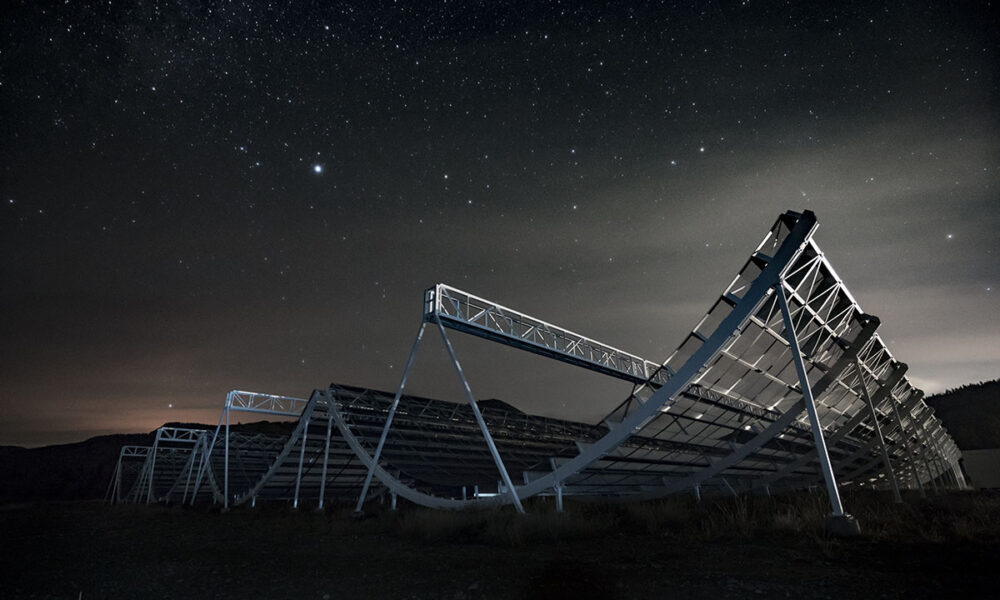On Apr. 28, 2020, an unusually intense fast radio burst (FRB) was detected by the Canadian Hydrogen Intensity Mapping Experiment (CHIME) telescope located near Penticton, British Columbia. Although it was only partially captured by the telescope, the radio burst was intense enough in magnitude that, according to scientists working on the project, it outpowered the average detected FRB by a factor of 15. Upon detecting the fast radio burst, CHIME observers manually sent out an astronomer’s telegram to other astronomers observing that region of the sky.
“[An astronomer’s telegram] is a one-paragraph blurb sent out to the community to basically say ‘hey, I detected something, you guys should point your telescopes at it,’” Paul Scholz, a fellow at the University of Toronto’s Dunlap Institute for Astronomy and Astrophysics, explained to The McGill Tribune. “[Observers using x-ray telescopes] looked back at their data and found that there was also an x-ray event at the time of the fast radio burst.”
In conjunction with data other telescopes provided, astronomers discovered that a magnetar located in the Milky Way galaxy was the cause of the fast radio burst. Functionally a neutron star with an immense magnetic field, a magnetar would be capable of producing the type of fast radio burst that CHIME detected.
The CHIME telescope itself has a relatively unusual look for a telescope. Resembling four conjoined halfpipes, CHIME is able to survey a much larger swath of the sky than most other radio telescopes. In addition, the telescope has a broad frequency coverage of 400 to 800 MHz, making CHIME ideal for mapping the presence of hydrogen gas. Since hydrogen gas is the most abundant element in the universe, measuring its expansion rate allows cosmologists to find the expansion rate of the universe itself.
“Five to seven billion years ago, [the universe] started accelerating outward. The slowing down diminished and now it’s expanding more rapidly every day,” Mark Halpern, a professor in the physics department at the University of British Columbia, said in an interview with The McGill Tribune. “We’re trying to explore this shape change in the expansion history. The way we would like to do that is to measure how fast things are moving and how far away they are, looking back in time.”
A side proposal for CHIME was to monitor the radio burst emitted by pulsars visible from the northern hemisphere. Pulsars are neutron stars capable of producing FRBs much like magnetars, but with steady recurring pulses that magnetars lack. However, the project increased in scope, aiming to monitor signals from a wide range of FRBs; the difference was that their origin was completely unknown.
“Near the beginning of CHIME, we realized that it would be extremely useful for detecting fast radio bursts,” Scholz explained. “In the decade before CHIME started up, there had been around 50 FRBs detected. We went from 50 FRBs […] to 500 FRBs in a year.”
So far, CHIME has been able to map over 1000 FRBs, including the magnetar detected in April 2020. This has allowed scientists to conclude that magnetars are at least one possible cause for some of the FRBs detected by CHIME.
To speed up the identification process, a new system was set up to make the data much more accessible to the wider scientific community. The system, called CHIME VOEvent Service, releases curated samples of the detected FRBs with their original frequency and size. This automation increases the speed at which the detection of fast radio bursts can be communicated to other telescopes, allowing them to work more efficiently with each other.
“We can expect many new observations of FRBs to be taken by a variety of telescopes around the world, as they respond to the VOEvent trigger just moments after an FRB occurs,” wrote Andrew Zwaniga, the lead developer of the CHIME/FRB VOEvent Service and a research assistant in the physics department at McGill, in an email to the Tribune. “This will give a new window into the kinds of signals that may accompany FRBs, such as optical light, X-rays, and gamma-rays. This could be crucial to understanding the engine that produces an FRB.”
As it enters its fourth year, the project continues to accumulate data. With every passing year, astronomers get closer and closer to uncovering further glimmers of the mysterious workings of the universe.









